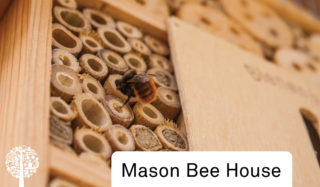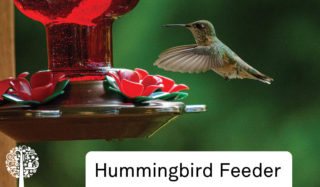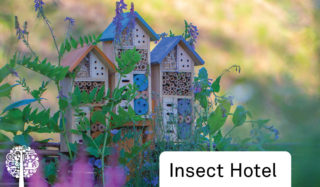Bees, birds, butterflies, insects, moths, and even bats are crucial to a thriving and active ecosystem. According to the US Department of Agriculture (USDA), three-fourths of the planet’s flowering plants and 35% of food crops depend on these pollinators to reproduce.
By transporting pollen from the male anther to the female stigma, plants become fertilized and able to produce seeds and fruit. Without this occurring, plants can’t reproduce, and every ecosystem collapses.
Habitat loss, disease, parasites, environmental contaminants, and weather events such as heat waves and droughts caused by climate change have all limited the pollinator’s ability to find quality food. So let’s give them some love this holiday season, shall we?

Mason Bee House
Mason bees are hole nesters, and the uniform cylinder tunnels of a mason bee house make for cozy homes. Easy to find in garden centers and big box stores, these habitats can be attached to a garden post, the side of the house, or a tree. Who doesn’t want mason bees thriving in their garden? They rarely sting and are messy foragers, spilling pollen everywhere as they travel from flower to flower. This makes them great for enhancing the biodiversity in the garden.

Hummingbird Feeder
One hummingbird can visit between one thousand to three thousand plants daily, sucking up the nectar and transferring pollen around the garden. Their tiny wings gyrate at incredible speeds, keeping them in constant suspension, which takes a lot of calories. A hummingbird feeder can give these busy pollinators extra energy to accomplish their important work for Mother Nature. For some, like Anna’s hummingbird, which doesn’t migrate south, feeders are an essential food source in winter when flower nectar is unavailable.

Hummingbird Nectar Supply
Everyone’s busy, and taking time to make the simple nectar for the hummingbird feeder can be one of those chores that are put on the back burner or forgotten about. Giving a generous ready-made supply of hummingbird nectar is a great time saver for the busy gardener. Big box stores, garden centers, and nature stores carry pre-mixed supplies.
Pollinator Seed Mix
To attract pollinators to your garden, planting the right flowers makes a difference. For example, bees cannot see red, but hummingbirds are attracted to the vibrant color. Pollinator seed packets are available at local garden centers, online shops, and big box stores. Or, save them from your own garden! These seeds can generally be sowed straight into the ground in the spring and grow into an array of brightly colored plants, each suited to a different group of pollinators. The packet you gift should include not just a variety of colors but plants that bloom throughout the growing season to ensure these stalwarts of the ecosystem have enough to feed on from spring to fall.

Birdbath or Water Feature
Water is the gift of life. We all need it, and pollinators are no exception. A birdbath, basin, or decorative hollow stone is a great water source for pollinators, not to mention an attractive addition to the garden. Pick a feature that provides landing spots for butterflies and hummingbirds, and make sure to replenish it often with filtered, clean water.

Insect Hotel
Beetles, ants, and other insects are great little pollen carriers but are often forgotten. Mistaken for mason bee houses, an insect hotel also has cylinder compartments. But unlike a mason bee house, the compartments are different sizes to accommodate all the guests.

The garden and the planet will thrive by giving the gift of pollination this holiday season. It’s a win-win for everyone!